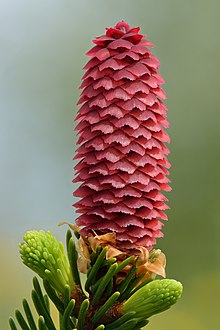Picea abies
The common spruce, Norway spruce or European spruce (Picea abies), is a conifer of the Pinaceae family. Although it is sometimes popularly identified as a species of fir and more specifically as red spruce, strictly speaking it is not a fir, as it does not belong to the genus Abies, that of the fir trees, which is why it is also known as false fir.
Distribution
Native to the central and eastern part of Europe, from the Nordic countries to the Balkans, it usually forms forests at altitudes above 800 m s. no. m., frequently coexisting with the European larch. It is one of the most common trees in the entire area of the Alps, from eastern France, northern Italy, southern Switzerland, Austria and the Balkans.
The red fir is present in Spain due to repopulations in the Pyrenees, Cantabria and north of Castilla y León. In the Province of Palencia there is a 3,500 m² grove in San Andrés de Arroyo (near Alar del Rey).
Description
It is a large dark-green evergreen conifer that reaches a height of between 30-50 m and a trunk diameter of 1-1.5 m. The characteristic of this spruce is its pyramidal crown, very regular, with the branches arranged ascending near the crown. It can reach 70 m in height. The tallest Norway spruce is 63 m, and is found in the Perućica virgin forest in Sutjeska National Park, Bosnia-Herzegovina.
Its branches grow horizontally except in the upper area, where they are arranged ascending. It has a straight trunk, cones, and reddish-brown bark (hence its name) that flakes slightly with age. It presents acicular leaves between 1 and 2.5 cm in length, rigid and pointed, arranged in whorls and of a glossy dark green color, with a quadrangular cross section. The new branches that sprout in spring are yellow-green.
The cones (cones) as in the rest of the spruce species, are hanging, ovoid in shape and between 10-18 cm long, being the longest of the spruces. The cones are green or reddish and when mature, 5-7 months after pollination, they turn brownish-brown or purplish. They have triangular scales. Seeds are black 4-5 mm long with a 15 mm light brown wing.
Uses
In many northern European countries it is considered the typical Christmas fir. It is highly appreciated in gardening, occupying a prominent place in European parks and gardens and is also used for reforestation due to its wood, light in color, very workable and with a fine finish; Ideal for cabinetmaking or for making musical instruments, the famous Stradivarius violins were made from this type of tree. Fazioli, a renowned piano manufacturer thanks to its great sound, uses this same wood for its pianos.
The oldest tree in the world
In April 2008, scientists from Umeå University (Sweden) discovered a specimen of Picea with a 9,550-year-old root system. It is called Old Tjikko. The longevity of the spruce is due, on the one hand, to its double capacity to clone itself from the root reserves, and on the other, to adapting to climatic changes, evolving from tree to shrub. It is considered the oldest living tree in the world. It is currently in the province of Dalarna, Sweden.
Taxonomy
Picea abies was first described by Charles Linnaeus as Pinus abies and published in Species Plantarum, vol. 2 P. 1002[2], 1753, and later attributed to the genus Picea by Gustav Karl Wilhelm Hermann Karsten and published in Encyclopédie Méthodique. Botanique... Supplement 5(1): 35. 1817.
- Etymology
- Picea: borrowed from Latin pix."brea" of the Greek πισα, classic name given to a pine that produced this substance
- abies: Latin epithet that means "abeto".
Varieties
There are a few forms of this spruce:
- P. abies 'Aurea' - yellow foliage.
- P. abies 'Pendula' - hanging branches.
- P. abies 'Argenta' - silver-white foliage.
- P. abies 'Nana' - orange foliage and between 30 - 60 cm high only.
- Picea abies var. europaea (Tepl.) Jurkev. " Parv.
- Sinonimia
- Abis abies (L.) Druce
- Abis alpestris Brügger
- Carpathian abyss (Loudon) Ravenscr.
- Abies cinerea Borkh.
- Abis clambrasiliana Lavallée
- Abis clanbrassiliana Loudon
- Abies coerulescens K.Koch
- Abies communis P.Lawson
- Abis commutata var. mucronata Loudon
- Abis conica Lavallée
- Abis cranstonii Lavallée
- Abies elegans Sm. ex J.Knight
- Abis Eremite K.Koch
- Abies erythrocarpa (Purk.) Nyman
- Abis excelsa (Lam.) Poir.
- Extreme Abis Th.Fr.
- Abis finedonensis Gordon
- Giant Abis Sm. ex Carrière
- Abies Gregoryana H.Low. ex Gordon
- Abies invert R.Sm. ex Gordon
- Limonian Abis Booth ex Gordon
- Abis medioxima C.Lawson
- Abis minima Lavallée
- Abis minut Poir.
- Abis mountain Nyman
- Abis mucronata Rausch ex Carrière
- Abis Parvula Knight
- Abis pectinata Gilib.
- Abis picea Mill.
- Abis pumila Voss
- Abis subarctica (Schur) Nyman
- Abies viminalis Wahlenb.
- Abies vulgaris Wender.
- Picea alpestris (Brügger) Stein
- Picea cranstonii Beissn.
- Picea elegantissima Beissn.
- Picea excelsa (Lam.) Link
- Picea finedonensis Beissn.
- Picea gregoryana Beissn.
- Picea fundamentalisquamis (Carrière) Chiov.
- Picea maxwellii Beissn.
- Picea montana Schur
- Picea obovata var. alpestris (Brügger) A.Henry
- Picea remontii Beissn.
- Picea rubra A.Dietr.
- Subarctic Picea Schur
- Sailing Picea Simonk. ex Kümmerle
- Picea viminalis (Alstr.) Beissn.
- Picea vulgaris Link
- Pinus abies L.
- Pinus carpatica Gordon
- Pinus cinerea Röhl.
- Pinus clanbrasiliana J.Forbes
- Pinus excelsa Lam.
- Pinus picea Du Roi
- Pinus pyramidalis Salisb.
- Pinus sativa Lam.
- Pinus viminalis Alstr.
Contenido relacionado
Hickelia
Dendrochloa distans
Origanum vulgare
Thamnocalamus
Deschampsia







